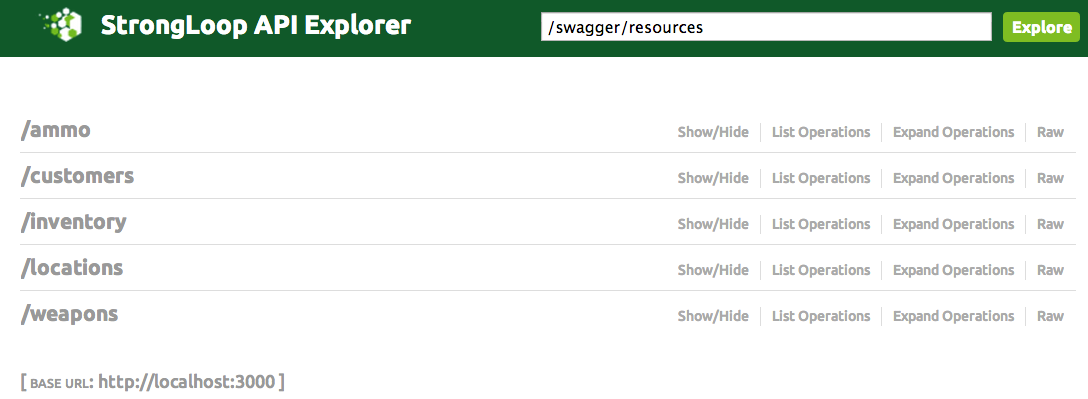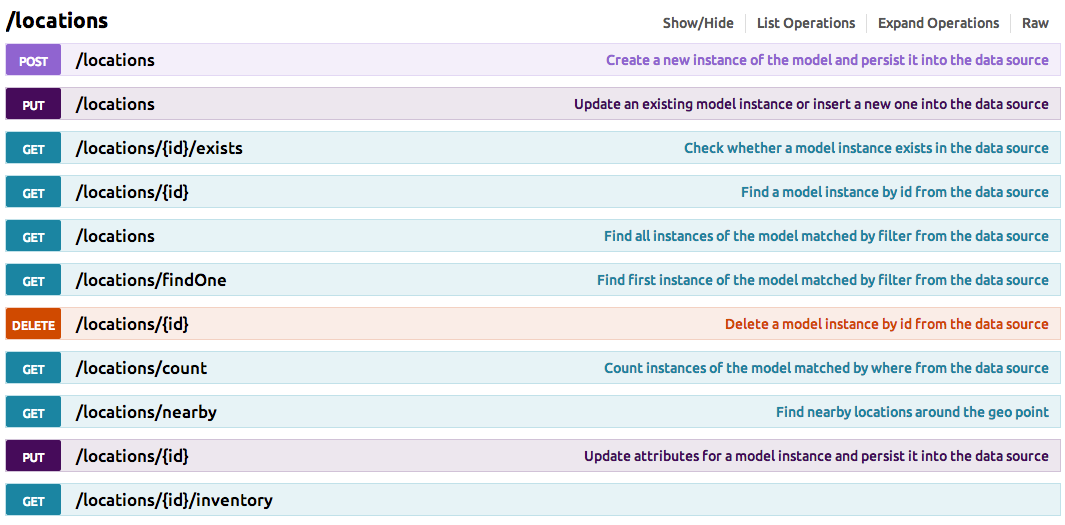4.5 KiB
API Explorer
LoopBack helps you build APIs for mobile applications. As you follow the steps
to create a project and add models using the slc lb command line tool, REST
APIs are automatically added to your application.
Now we have a handful of REST APIs. It would be nice to see the list of APIs and try them out without writing code. We can do that! LoopBack provides a Web based API explorer out of the box to document and explore REST APIs for the models.
Let's give a try first.
API Explorer UI
Step 1: Run the sample application
$ cd sls-sample-app
$ slc run app
Step 2: Open your browser and point to http://localhost:3000/explorer. You'll see a list of REST API endpoints as illustrated below.
The endpoints are grouped by the model names. Each endpoint consists of a list of operations for the model.
Step 3: Click on one of the endpoint paths (such as /locations) to see available operations for a given model.
Great, now you see the CRUD operations mapped to HTTP verbs and paths.
Step 4: Click on a given operation to see the signature
Please note each operation has the HTTP verb, path, description, response model, and a list of request parameters.
Step 5: Try to invoke an operation
Fill in the parameters, and then click on Try it out! button.
Here we go:
Cool, we can invoke the REST APIs without writing code!
You might be curious about the magic behind it all. Let's reveal a bit to you.
REST API specs
LoopBack API Explorer is built on top of the popular Swagger Framework. There are two components involved.
-
LoopBack builds up formal specifications of the REST APIs using the knowledge of model definitions, JavaScript method declarations, and remote mappings. The specifications are served over the following endpoints.
-
The wonderful Web UI is brought you by Swagger UI. Swagger UI is a collection of HTML, Javascript, and CSS assets that dynamically generate beautiful documentation and sandbox from the REST API specifications.
Resource Listing
The first part is a listing of the REST APIs.
-
http://localhost:3000/swagger/resources
{ "swaggerVersion": "1.1", "basePath": "http://localhost:3000", "apis": [ { "path": "/swagger/ammo" }, { "path": "/swagger/customers" }, { "path": "/swagger/inventory" }, { "path": "/swagger/locations" }, { "path": "/swagger/weapons" } ] }
Resource Operations
The second part describes all operations of a given model.
-
http://localhost:3000/swagger/locations
{ "swaggerVersion": "1.1", "basePath": "http://localhost:3000", "apis": [ { "path": "/locations", "operations": [ { "httpMethod": "POST", "nickname": "locations_create", "responseClass": "object", "parameters": [ { "paramType": "body", "name": "data", "description": "Model instance data", "dataType": "object", "required": false, "allowMultiple": false } ], "errorResponses": [], "summary": "Create a new instance of the model and persist it into the data source", "notes": "" } ] }, ... { "path": "/locations/{id}", "operations": [ { "httpMethod": "GET", "nickname": "locations_findById", "responseClass": "any", "parameters": [ { "paramType": "path", "name": "id", "description": "Model id", "dataType": "any", "required": true, "allowMultiple": false } ], "errorResponses": [], "summary": "Find a model instance by id from the data source", "notes": "" } ] }, ... ] }
Note: The API specifications will be enhanced in future releases to include the model definitions.



